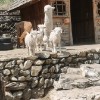
时间序列分析:预测与控制
¥ 17 2.6折 ¥ 65 八五品
仅1件
北京大兴
认证卖家担保交易快速发货售后保障
作者[美]GeorgeE.P.Box、[英]GwilymM.Jenkins、[美]GregoryC.Reinsel 著
出版社人民邮电出版社
出版时间2005-09
版次1
装帧平装
货号2-2
上书时间2024-06-29
- 最新上架
商品详情
- 品相描述:八五品
图书标准信息
- 作者 [美]GeorgeE.P.Box、[英]GwilymM.Jenkins、[美]GregoryC.Reinsel 著
- 出版社 人民邮电出版社
- 出版时间 2005-09
- 版次 1
- ISBN 9787115137722
- 定价 65.00元
- 装帧 平装
- 开本 16开
- 纸张 胶版纸
- 页数 598页
- 字数 840千字
- 正文语种 英语
- 丛书 图灵原版数学·统计学系列
- 【内容简介】
-
本书自1970年初版以来,不断修订再版,以其经典性和权威性成为有关时间序列分析领域书籍的典范。书中涉及时间序列随机(统计)模型的建立及许多重要的应用领域的使用,包括预测,模型的描述、估计、识别和诊断,动态关系的传递函数的识别、拟合及检验,干预事件影响的建模和过程控制等专题。本书叙述简明,强调实际技术,配有大量实例。
本书可作为统计和相关专业高年级本科生或研究生教材,也可以作为统计专业技术人员的参考书。 - 【作者简介】
-
GeorgeE.P.Box国际级统计学家。曾于1960年创立威斯康星大学统计系并任该系主任,现为该校名誉教授。BOX发表过200多篇论文,出版过很多重要著作,其中本书和STATISTICEFOR
EXPERIMENTERS为其代表作。
GwilymM.Jenkins已故国际级统计学家。曾于1966年创立了英国兰开斯特大学系统工程系。JENKINS与BOX合作的成果对时间序列分析方法的研究和应用产生了巨大的推动作用。
GregoryC.Reinsel已故国际级统计学家。1995-1997年任威斯康星大学统计系系主任。因在统计领域的突出贡献而被推举为美国统计协会会士。 - 【目录】
-
1 INTRODUCTION 1
1.1 FourImportantPracticalProblems 2
1.1.1 ForecastingTimeSeries 2
1.1.2 EstimationofTransferFunctions 3
1.1.3 AnalysisofEffectsofUnusualInterventionEventsToaSystem 4
1.1.4 DiscreteControlSystems 5
1.2 StochasticandDeterministicDynamicMathematicalModels 7
1.2.1 StationaryandNonstationaryStochasticModelsforForecastingandControl 7
1.2.2 TransferFunctionModels 12
1.2.3 ModelsforDiscreteControlSystems 14
1.3 BasicIdeasinModelBuilding 16
1.3.1 Parsimony 16
1.3.2 IterativeStagesintheSelectionofaModel 16
PartI StochasticModelsandTheirForecasting 19
2 AUTOCORRELATIONFUNCTIONANDSPECTRUMOFSTATIONARYPROCESSES 21
2.1 AutocorrelationPropertiesofStationaryModels 21
2.1.1 TimeSeriesandStochasticProcesses 21
2.1.2 StationaryStochasticProcesses 23
2.1.3 PositiveDefinitenessandtheAutocovarianceMatrix 26
2.1.4 AutocovarianceandAutocorrelationFunctions 29
2.1.5 EstimationofAutocovarianceandAutocorrelationFunctions 30
2.1.6 StandardErrorofAutocorrelationEstimates 32
2.2 SpectralPropertiesofStationaryModels 35
2.2.1 PeriodogramofaTimeSeries 35
2.2.2 AnalysisofVariance 36
2.2.3 SpectrumandSpectralDensityFunction 37
2.2.4 SimpleExamplesofAutocorrelationandSpectralDensityFunctions 41
2.2.5 AdvantagesandDisadvantagesoftheAutocorrelationandSpectralDensityFunctions 43
A2.1 LinkBetweentheSampleSpectrumandAutocovarianceFunctionEstimate 44
3 LINEARSTATIONARYMODELS 46
3.1 GeneralLinearProcess 46
3.1.1 TwoEquivalentFormsfortheLinearProcess 46
3.1.2 AutocovarianceGeneratingFunctionofaLinearProcess 49
3.1.3 StationarityandInvertibilityConditionsforaLinearProcess 50
3.1.4 AutoregressiveandMovingAverageProcesses 52
3.2 AutoregressiveProcesses 54
3.2.1 StationarityConditionsforAutoregressiveProcesses 54
3.2.2 AutocorrelationFunctionandSpectrumofAutoregressiueProcesses 55
3.2.3 First-OrderAutoregressive(Markov)Process 58
3.2.4 Second-OrderAutoregressiveProcess 60
3.2.5 PartialAutocorrelationFunction 64
3.2.6 EstimationofthePartialAutocorrelationFunction 67
3.2.7 StandardErrorsofPartialAutocorrelationEstimates 68
3.3 MovingAverageProcesses 69
3.3.1 InvertibilityConditionsforMovingAverageProcesses 69
3.3.2 AutocorrelationFunctionandSpectrumofMovingAverageProcesses 70
3.3.3 First-OrderMovingAverageProcess 72
3.3.4 Second-OrderMovingAverageProcess 73
3.3.5 DualityBetweenAutoregressiveandMovingAverageProcesses 75
3.4 MixedAutoregressive-MovingAverageProcesses 77
3.4.1 StationarityandInvertibilityProperties 77
3.4.2 AutocorrelationFunctionandSpectrumofMixedProcesses 78
3.4.3 First-OrderAutoregressive-First-OrderMovingAverageProcess 80
3.4.4 Summary 83
A3.1 AutocovariancesAutocovarianceGeneratingFunctionandStationarityConditionsforaGeneralLinearProcess 85
A3.2 RecursiveMethodforCalculatingEstimatesofAutoregressiveParameters 87
4 LINEARNONSTATIONARYMODELS 89
4.1 AutoregressiveIntegratedMovingAverageProcesses 89
4.1.1 NonstationaryFirst-OrderAutoregressiveProcess 89
4.1.2 GeneralModelforaNonstationaryProcessExhibitingHomogeneity 92
4.1.3 GeneralFormoftheAutoregressiveIntegratedMovingAverageProcess 96
4.2 ThreeExplicitFormsfortheAutoregressiveIntegratedMovingAverageModel 99
4.2.1 DifferenceEquationFormoftheModel 99
4.2.2 RandomShockFormoftheModel I00
4.2.3 InvertedFormoftheModel 106
4.3 IntegratedMovingAverageProcesses 109
4.3.1 IntegratedMovingAverageProcessofOrder(0,1,1) 110
4.3.2 IntegratedMovingAverageProcessofOrder(0,2,2) 114
4.3.3 GeneralIntegratedMovingAverageProcessofOrder(0,d,q) 118
A4.1 LinearDifferenceEquations 120
A4.2 IMA(0,1,1)ProcessWithDeterministicDrift 125
A4.3 ARIMAProcessesWithAddedNoise 126
A4.3.1 SumofTwoIndependentMovingAverageProcesses 126
A4.3.2 EffectofAddedNoiseontheGeneralModel 127
A4.3.3 ExampleforanIMA(O,1,1)ProcesswithAddedWhiteNoise 128
A4.3.4 RelationBetweentheIMA(O,1,1)ProcessandaRandomWalk 129
A4.3.5 AutocovarianceFunctionoftheGeneralModelwithAddedCorrelatedNoise 129
5 FORECASTING 131
5.1 MinimumMeanSquareErrorForecastsandTheirProperties 131
5.1.1 DerivationoftheMinimumMeanSquareErrorForecasts 133
5.1.2 ThreeBasicFormsfortheForecast 135
5.2 CalculatingandUpdatingForecasts 139
5.2.1 ConvenientFormatfortheForecasts 139
5.2.2 CalculationoftheψWeights 139
5.2.3 UseoftheψWeightsinUpdatingtheForecasts 141
5.2.4 CalculationoftheProbabilityLimitsoftheForecastsatAnyLeadTime 142
5.3 ForecastFunctionandForecastWeights 145
5.3.1 EventualForecastFunctionDeterminedbytheAutoregressiveOperator 146
5.3.2 RoleoftheMooingAverageOperatorinFixingtheInitialValues 147
5.3.3 LeadlForecastWeights 148
5.4 ExamplesofForecastFunctionsandTheirUpdating 151
5.4.1 ForecastinganIMA(O,1,1)Process 151
5.4.2 ForecastinganIMA(O,2,2)Process 154
5.4.3 ForecastingaGeneralIMA(O,d,q)Process 156
5.4.4 ForecastingAutoregressiveProcesses 157
5.4.5 Forecastinga(1,O,1)Process 160
5.4.6 Forecastinga(1,1,1)Process 162
5.5 UseofStateSpaceModelFormulationforExactForecasting 163
5.5.1 StateSpaceModelRepresentationfortheARIMAProcess 163
5.5.2 KalmanFilteringRelationsforUseinPrediction 164
5.6 Summary 166
A5.1 CorrelationsBetweenForecastErrors 169
A5.1.1 AutocorrelationFunctionofForecastErrorsatDifferentOrigins 169
A5.1.2 CorrelationBetweenForecastErrorsattheSameOriginwithDifferentLeadTimes 170
A5.2 ForecastWeightsforAnyLeadTime 172
A5.3 ForecastinginTermsoftheGeneralIntegratedForm 174
A5.3.1 GeneralMethodofObtainingtheIntegratedForm 174
A5.3.2 UpdatingtheGeneralIntegratedForm 176
A5.3.3 ComparisonwiththeDiscountedLeastSquaresMethod 176
PartII StochasticModelBuilding 181
6 MODELDENTIFICATION 183
6.l ObjectivesofIdentification 183
6.1.1 StagesintheIdentificationProcedure 184
6.2 IdentificationTechniques 184
6.2.1 UseoftheAutocorrelationandPartialAutocorrelationFunctionsinIdentification 184
6.2.2 StandardErrorsforEstimatedAutocorrelationsandPartialAutocorrelations 188
6.2.3 IdentificationofSomeActualTimeSeries 188
6.2.4 SomeAdditionalModelIdentificationTools 197
6.3 InitialEstimatesfortheParameters 202
6.3.1 UniquenessofEstimatesObtainedfromtheAutocovarianceFunction 202
6.3.2 InitialEstimatesforMovingAverageProcesses 202
6.3.3 InitialEstimatesforAutoregressiveProcesses 204
6.3.4 InitialEstimatesforMixedAutoregressive-MovingAverageProcesses 206
6.3.5 ChoiceBetweenStationaryandNonstationaryModelsinDoubtfulCases 207
6.3.6 MoreFormalTestsforUnitRootsinARIMAModels 208
6.3.7 InitialEstimateofResidualVariance 211
6.3.8 ApproximateStandardErrorfor 212
6.4 ModelMultiplicity 214
6.4.1 MultiplicityofAutoregressive-MovingAverageModels 214
6.4.2 MultipleMomentSolutionsforMovingAverageParameters 216
6.4.3 UseoftheBackwardProcesstoDetermineStartingValues 218
A6.1 ExpectedBehavioroftheEstimatedAutocorrelationFunctionforaNonstationaryProcess 218
A6.2 GeneralMethodforObtainingInitialEstimatesoftheParametersofaMixedAutoregressive-MovingAverageProcess 220
7 MODELESTIMATION 224
7.l StudyoftheLikelihoodandSumofSquaresFunctions 224
7.1.1 LikelihoodFunction 224
7.1.2 ConditionalLikelihoodforanARIMAProcess 226
7.1.3 ChoiceofStartingValuesforConditionalCalculation 227
7.1.4 UnconditionalLikelihood;SumofSquaresFunction;LeastSquaresEstimates 228
7.1.5 GeneralProcedureforCalculatingtheUnconditionalSumofSquares 233
7.1.6 GraphicalStudyoftheSumofSquaresFunction 238
7.1.7 Descriptionof“Well-Behaved”EstimationSituations;ConfidenceRegions 241
7.2 NonlinearEstimation 248
7.2.1 GeneralMethodofApproach 248
7.2.2 NumericalEstimatesoftheDerivatives 249
7.2.3 DirectEvaluationoftheDerivatives 251
7.2.4 GeneralLeastSquaresAlgorithmfortheConditionalModel 252
7.2.5 SummaryofModelsFittedtoSeriesAtoF 255
7.2.6 Large-SampleInformationMatricesandCovarianceEstimates 256
7.3 SomeEstimationResultsforSpecificModels 259
7.3.1 AutoregressiveProcesses 260
7.3.2 MovingAverageProcesses 262
7.3.3 MixedProcesses 262
7.3.4 SeparationofLinearandNonlinearComponentsinEstimation 263
7.3.5 ParameterRedundancy 264
7.4 EstimationUsingBayesTheorem 267
7.4.1 BayesTheorem 267
7.4.2 BayesianEstimationofParameters 269
7.4.3 AutoregressiveProcesses 270
7.4.4 MovingAverageProcesses 272
7.4.5 Mixedprocesses 274
7.5 LikelihoodFunctionBasedonTheStateSpaceModel 275
A7.1 ReviewofNormalDistributionTheory 279
A7.1.1 PartitioningofaPositive-DefiniteQuadraticForm 279
A7.1.2 TwoUsefulIntegrals 280
A7.1.3 NormalDistribution 281
A7.1.4 Studentst-Distribution 283
A7.2 ReviewofLinearLeastSquaresTheory 286
A7.2.1 NormalEquations 286
A7.2.2 EstimationofResidualVariance 287
A7.2.3 CovarianceMatrixofEstimates 288
A7.2.4 ConfidenceRegions 288
A7.2.5 CorrelatedErrors 288
A7.3 ExactLikelihoodFunctionforMovingAverageandMixedProcesses 289
A7.4 ExactLikelihoodFunctionforanAutoregressiveProcess 296
A7.5 ExamplesoftheEffectofParameterEstimationErrorsonProbabilityLimitsforForecasts 304
A7.6 SpecialNoteonEstimationofMovingAverageParameters 307
8 MODELDIAGNOSTICCHECKING 308
8.1 CheckingtheStochasticModel 308
8.1.1 GeneralPhilosophy 308
8.1.2 Overfitting 309
8.2 DiagnosticChecksAppliedtoResiduals 312
8.2.1 AutocorrelationCheck 312
8.2.2 PortmanteauLack-of-FitTest 314
8.2.3 ModelInadequacyArisingfromChangesinParameterValues 317
8.2.4 ScoreTestsforModelChecking 318
8.2.5 CumulativePeriodogramCheck 321
8.3 UseofResidualstoModifytheModel 324
8.3.1 NatureoftheCorrelationsintheResidualsWhenanIncorrectModelIsUsed 324
8.3.2 UseofResidualstoModifytheModel 325
9 SEASONALMODELS 327
9.1 ParsimoniousModelsforSeasonalTimeSeries 327
9.1.1 FittingversusForecasting 328
9.1.2 SeasonalModelsInvolvingAdaptiveSinesandCosines 329
9.1.3 GeneralMultiplicativeSeasonalModel 330
9.2 RepresentationoftheAirlineDatabyaMultiplicative(0,1,1)~(0,1,1)12SeasonalModel 333
9.2.1 Multiplicative(0,l,l)~(0,l,1)12Model 333
9.2.2 Forecasting 334
9.2.3 Identification 341
9.2.4 Estimation 344
9.2.5 DiagnosticChecking 349
9.3 SomeAspectsofMoreGeneralSeasonalModels 351
9.3.1 MultiplicativeandNonmultiplicativeModels 351
9.3.2 Identification 353
9.3.3 Estimation 355
9.3.4 EventualForecastFunctionsforVariousSeasonalModels 355
9.3.5 ChoiceofTransformation 358
9.4 StructuralComponentModelsandDeterministicSeasonalComponents 359
9.4.1 DeterministicSeasonalandTrendComponentsandCommonFactors 360
9.4.2 ModelswithRegressionTermsandTimeSeriesErrorTerms 361
A9.1 AutocovariancesforSomeSeasonalModels 366
PartIII TransferFunctionModelBuilding 371
10 TRANSFERFUNCTIONMODELS 373
10.1 LinearTransferFunctionModels 373
10.1.1 DiscreteTransferFunction 374
10.1.2 ContinuousDynamicModelsRepresentedbyDifferentialEquations 376
10.2 DiscreteDynamicModelsRepresentedbyDifferenceEquations 381
10.2.1 GeneralFormoftheDifferenceEquation 381
10.2.2 NatureoftheTransferFunction 383
10.2.3 First-andSecond-OrderDiscreteTransferFunctionModels 384
10.2.4 RecursiveComputationofOutputforAnyInput 390
10.2.5 TransferFunctionModelswithAddedNoise 392
10.3 RelationBetweenDiscreteandContinuousModels 392
10.3.1 ResponsetoaPulsedInput 393
10.3.2 RelationshipsforFirst-andSecond-OrderCoincidentSystems 395
10.3.3 ApproximatingGeneralContinuousModelsbyDiscreteModels 398
A10.1 ContinuousModelsWithPulsedInputs 399
A10.2 NonlinearTransferFunctionsandLinearization 404
11 IDENTIFICATIONFITTINGANDCHECKINGOFTRANSFERFUNCTIONMODELS 407
ll.1 CrossCorrelationFunction 408
11.1.1 PropertiesoftheCrossCovarianceandCrossCorrelationFunctions 408
11.1.2 EstimationoftheCrossCovarianceandCrossCorrelationFunctions 411
11.1.3 ApproximateStandardErrorsofCrossCorrelationEstimates 413
11.2 IdentificationofTransferFunctionModels 415
11.2.1 IdentificationofTransferFunctionModelsbyPrewhiteningtheInput 417
11.2.2 ExampleoftheIdentificationofaTransferFunctionModel 419
11.2.3 IdentificationoftheNoiseModel 422
11.2.4 SomeGeneralConsiderationsinIdentifyingTransferFunctionModels 424
11.3 FittingandCheckingTransferFunctionModels 426
11.3.1 ConditionalSumofSquaresFunction 426
11.3.2 NonlinearEstimation 429
11.3.3 UseofResidualsforDiagnosticChecking 431
11.3.4 SpecificChecksAppliedtotheResiduals 432
11.4 SomeExamplesofFittingandCheckingTransferFunctionModels 435
11.4.1 FittingandCheckingoftheGasFurnaceModel 435
11.4.2 SimulatedExamplewithTwoInputs 441
11.5 ForecastingUsingLeadingIndicators 444
11.5.1 MinimumMeanSquareErrorForecast 444
11.5.2 ForecastofC02OutputfromGasFurnace 448
11.5.3 ForecastofNonstationarySalesDataUsingaLeadingIndicator 451
11.6 SomeAspectsoftheDesignofExperimentstoEstimateTransferFunctions 453
A11.1 UseofCrossSpectralAnalysisforTransferFunctionModelIdentification 455
All.I.1 IdentificationofSingleInputTransferFunctionModels 455
All.l.2 IdentificationofMultipleInputTransferFunctionModels 456
AI1.2 ChoiceofInputtoProvideOptimalParameterEstimates 457
All.2.1 DesignofOptimalInputsforaSimpleSystem 457
All.2.2 NumericalExample 460
12 INTERVENTIONANALYSISMODELSANDOUTLIERDETECTION 462
12.1 InterventionAnalysisMethods 462
12.1.1 ModelsforInterventionAnalysis 462
12.1.2 ExampleofInterventionAnalysis 465
12.1.3 NatureoftheMLEforaSimpleLevelChangeParameterModel 466
12.2 OutlierAnalysisforTimeSeries 469
12.2.1 ModelsforAdditiveandInnovationalOutliers 469
12.2.2 EstirmationofOutlierEffectforKnownTimingoftheOutlier 470
12.2.3 IterativeProcedureforOutlierDetection 471
12.2.4 ExamplesofAnalysisofOutliers 473
12.3 EstimationforARMAModelsWithMissingValues 474
PartIV DesignofDiscreteControlSchemes 481
13 ASPECTSOFPROCESSCONTROL 483
13.1 ProcessMonitoringandProcessAdjustment 484
13.1.1 ProcessMonitoring 484
13.1.2 ProcessAdjustment 487
13.2 ProcessAdjustmentUsingFeedbackControl~488
13.2.1 FeedbackAdjustmentChart 489
13.2.2 ModelingtheFeedbackLoop 492
13.2.3 SimpleModelsforDisturbancesandDynamics 493
13.2.4 GeneralMinimumMeanSquareErrorFeedbackControlSchemes 497
13.2.5 ManualAdjustmentforDiscreteProportional-IntegralSchemes 499
13.2.6 ComplementaryRolesofMonitoringandAdjustment 503
13.3 ExcessiveAdjustmentSometimesRequiredbyMMSEControl 505
13.3.1 ConstrainedControl 506
13.4 MinimumCostControlWithFixedCostsofAdjustmentAndMonitoring 508
13.4.1 BoundedAdjustmentSchemeforFixedAdjustmentCost 508
13.4.2 IndirectApproachforObtainingaBoundedAdjustmentScheme 510
13.4.3 InclusionoftheCostofMonitoring 511
13.5 MonitoringValuesofParametersofForecastingandFeedbackAdjustmentSchemes 514
A13.1 FeedbackControlSchemesWheretheAdjustmentVarianceIsRestricted 516
A13.1.1 DerivationofOptimalAdjustment 517
A13.2 ChoiceoftheSamplingInterval 526
A13.2.1 IllustrationoftheEffectofReducingSamplingFrequency 526
A13.2.2 SamplinganIMA(O,I,I)Process 526
PartV ChartsandTables 531
COLLECTIONOFTABLESANDCHARTS 533
COLLECTIONOFTIMESERIESUSEDFOREXAMPLESINTHETEXTANDINEXERCISES 540
REFERENCES 556
PartVI EXERCISESANDPROBLEMS 569
INDEX 589
点击展开
点击收起
— 没有更多了 —



















以下为对购买帮助不大的评价